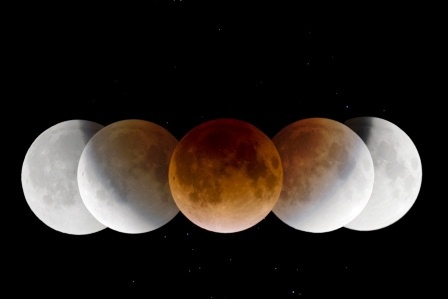 There is a very cool pic on Astronomy Pic of the Day. There was recently a lunar eclipse. I missed it because I was in Florida where it rained for about 4 solid days without CEASING. But that’s another story.
There is a very cool pic on Astronomy Pic of the Day. There was recently a lunar eclipse. I missed it because I was in Florida where it rained for about 4 solid days without CEASING. But that’s another story.
In any event, in this very cool photo, you can see the shape of the Earth’s shadow.

Old Copernicus would have been thrilled. He was careful to observe eclipses, both solar and lunar, because the casting of the shadow meant that the light source was at 180°, directly opposite.
Speaking of Copernicus, I just finished fairly light book by Dava Sobel A More Perfect Heaven: How Copernicus Revolutionized the Cosmos. (UK edition HERE)
This was sent to me by one of you readers. Sobel also wrote Longitude and Galileo’s Daughter. I find all them good reads, quite informative. She treats, in my opinion, the Church fairly.
UPDATE:
Traversing the shadow of the Earth, the Moon dimmed by degrees until fully immersed. Then, instead of disappearing in darkness, the eclipsed Moon daubed itself with the Sun’s color: It glowed like an ember throughout the hour of totality, reflecting all the dusk and dawn light that spilled into Earth’s shadow from the day before and the day ahead.
Copernicus never missed a lunar eclipse. No astronomer let such an opportunity slip, for the Moon in eclipse pinpointed celestial positions as no other phenomenon could. At such times the Earth’s shadow became visible on the Moon’s surface, and the center of that shadow indicated the location of the Sun—180° opposite in celestial longitude. With the Moon’s current coordinates thus confirmed, one could also measure the distances of stars and planets from either the Sun or the Moon. “In this area,” Copernicus remarked, “Nature’s kindliness has been attentive to human desires, inasmuch as the Moon’s place is determined more reliably through its eclipses than through the use of instruments, and without any suspicion of error.”
Even with the help of “Nature’s kindliness,” the tilt of the Moon’s orbit relative to the Earth’s great circle limited the frequency of lunar eclipses to once or at most twice a year, though some years have none. After August 26, there would not be another total lunar eclipse till the end of December 1525. At the moment of mid-eclipse, which Copernicus recorded on this occasion as 4:25 A.M., the Moon stood at opposition, yet stayed its course straight ahead. Unlike Jupiter or Saturn, the Moon never shifted into reverse at opposition—or ever, at any time—because the Moon, alone among all heavenly bodies, truly did orbit the Earth. “In expounding on the Moon’s motion,” Copernicus wrote, with no apparent irony, “I do not disagree with the ancients’ belief that it takes place around the Earth.”
Sobel, Dava (2011-10-04). A More Perfect Heaven: How Copernicus Revolutionized the Cosmos (Kindle Locations 702-718). Bloomsbury Publishing Plc. Kindle Edition.
Here is the quote from Sobel about Copernicus observing a lunar eclipse:


































I was just at the right longitude to see both sun and total eclipsed moon above the horizon at the same time. Apparently this is possible due to the refraction through the atmosphere of the light from both bodies. I didn’t actually see both sun and total eclipsed moon above the horizon at the same time–I was lolling in bed at the time. But I WAS just at the right longitude!
I was lucky enough to be entering St. Anne’s Church in San Diego at 5:15 am last Saturday when the eclipse was starting and was visible over the church. Our FSSP parish had a Rorate Mass in honor of Our Lady, an old Advent Tradition of German roots. The entire Traditional Mass was by candlelight only, with choir, organ, all 3 of our priests, and 5 altar boys. It was beautiful beyond description, and made even more special by the lunar eclipse taking place at the same time, symbolizing, together with the candles in the church, Mary’s utlimate triumph over darkness through her Son, the Light of the world.
Another interesting space watching event is Comet Lovejoy- visible today. Look to the left of the sun right around sunset.
That is a cool photo. And I too have enjoyed Dava Sobel’s books.
Fr. Z.,
Thank you for your book recommendations. I have learned of Don Camillo from you, as well as Archbishop Marchetto’s history of the council. You have cooperated in my attachment to Patrick O’Brian (I just finished The Surgeon’s Mate).
I will be teaching astronomy in the spring. This will be a great help. Please keep recommending texts.
Blessed “Oh days” to you.
For the eclipse I happened to be singing Mozart’s Requiem in Beijing–when we went outside afterwards we saw the moon nearly totally eclipsed. Made singing the “Dies Irae” and “Confutatis” more powerful! I’m sure they didn’t plan things that way, but the coincidence was lovely.
Nicholas Copernicus was not only an astronomer, but a physician, a canon lawyer, a deacon (and possibly even a priest), and…a Third Order Dominican (at least his whole family were Third Order Dominicans; unlikely he himself was not). Highly appropriate, as the patron saint of astronomers is — St. Dominic.
Motor terrae, solisque stator.
The great Father Z was in FL and I missed him! Alas Father some day I will buy you a cup of coffee and pick your brain.
Wow-what cool pictures of the eclipse!
‘Sun and moon, bless the Lord: praise and exalt Him above all forever!’